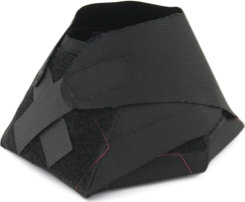If you have ridden in several American Competitive Trail Horse Association (ACTHA) Challenges, it is likely you have seen the rope gate obstacle. It struck me as odd to ride a six mile trail ride only to come to a simple rope gate as an obstacle. But I guess it serves to see if the horse and rider can position up to open and shut the rope gate. And of course the rope gate, which is safer than wire gates, is something you'd don't see in a pasture but is safe way to measure these skills.
ACTHA recognized that not all riding groups have access to six miles of trail, which also necessitate six different judges or a pretty well planned route and organized transportation system to move people for judges around, so they came up with the Arena Obstacle Challenge format. While ACTHA did not invent the arena obstacle format as many local and regional competitions have been using this type of obstacle format for decades, it is a great idea. Probably the most famous, or at least most challenging, of these arena obstacles are the Extreme Cowboy Racing Association (EXCA) founded by Craig Cameron years ago.
I'm of the opinion that if I spend hours trailering to and from an event, such as an arena challenge, I liked to ride against multiple and challenging obstacles. Some of this can be achieved by putting your imagination to work and designing obstacles that require multiple tasks on horseback using obstacles.
In other words, get multiple uses of your obstacles. This saves time and space, as well as letting the competitors go home thinking they got their money's worth.
The drawing above is a diagram on how to get more from your common rope gate obstacle. Basically the idea is to restrict approach to the rope gate so the rider has the challenge of positioning his/her horse for the gate as opposed to riding straight in.
After the rider opens the gate, moves through then closes the gate, a dismount is required. Then the rider opens the gate with his horse in hand, moves his horse through, then closes the gate. The last task would be to re-mount either from the fence or a mounting block.
The rope gate obstacle as run this way requires not only the ability to position up your horse for a side pass to open the gate, then go through and re-secure the gate, but also requires moving your horse in a tight circle or moving his hind end independently of the front end; it requires a demonstration of a safe dismount and how well the horse stands before an open gate before given the cue to proceed through the gate in hand; and lastly requires a mount from a mounting block or fence where the rider needs to position his/her horse to enable this mounting.
The gate in this instance is nothing more than a length of rope with a snap link on the gate opening end. A length of PVC pipe with a cross piece to retain the snap link serves as the gate latch. A traffic cone helps hold the PVC pipe in place and reminds the rider not to bump into it. The anchor end of the rope gate is simply secured to the arena fence. I'm using a lightweight wooden ground pole to restrict access/approach to the rope gate, but small traffic cones or a flour line poured onto the ground will work as well.
In the video below I am demonstrating how I think this obstacles should go, albeit smoother for better riders than I am.




















No comments:
Post a Comment